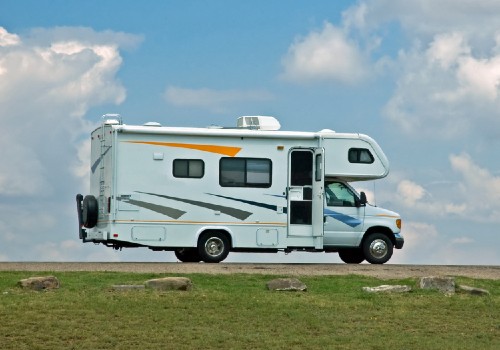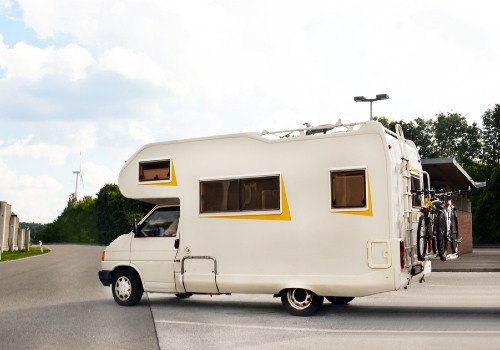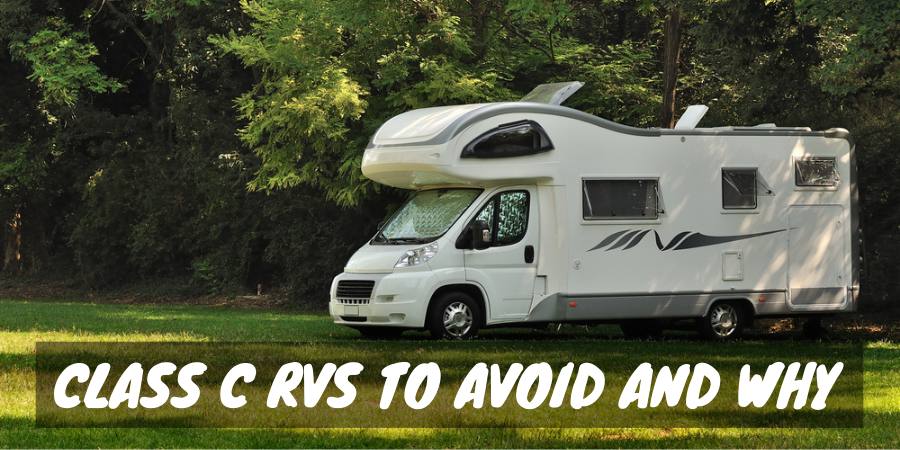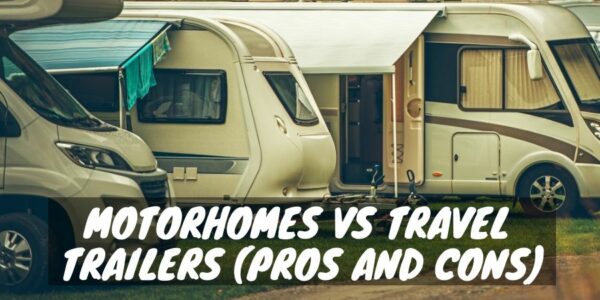Many of our readers ask what they should look for in a Class C motorhome. With so many options on the market, it’s hard to choose. We’ll walk through the various options out there and show you examples of Class C motorhomes to avoid based on their characteristics.
- Difficult Class C RV Corner Bed Access: Gulf Stream Conquest 6237LE
- The Big Problem With Sprinters: Jayco Melbourne 24T
- Negative RV Murphy Bed Reviews: Forest River Forester MBS 2401T
- Non-Extreme 4×4 Class C Motorhome: Nexus Rebel 35R
- Underwhelming Interior Storage: Winnebago Outlook 25J
Pros and Cons of Class C RVs

For a complete discussion on what a Class C RV is and its many attributes, check out our article on them. Class C motorhomes are the “happy medium” between the large bus-like Class A and small van-like Class B. RV manufacturers build Class C motor coaches as a family-friendly, drivable category with sleeping spaces of up to 10 or more.
It’s not hard to drive a Class C RV since manufacturers build them on van chassis. Many consumer reviews favorably compare the driving experience to the family SUV. Once European-style van chassis hit the American roads, RV manufacturers gave consumers two different Class C motorhomes to fit their camping lifestyle better.
The smaller fuel-efficient types come on the newer European-styled van chassis like the Mercedes Sprinter or Ford Transit. Many use the Ford E-Series or Chevrolet Express chassis if you prefer a larger version with more interior room and power. We’ll discuss the differences later on.
One of the disadvantages of Class C motorhomes has to do with the setup process. Unless you buy the optional equipment or add aftermarket components, Class C motorhomes don’t come with leveling jacks. To balance the RV, you must use stackable jack pads underneath the tires. You build them up beforehand, place them in front of your tires, and slowly drive onto them.
Class C motorhomes don’t hold their value like houses. On average, RVs lose 20-30% of their value each year. To retain as much value as possible, keep up with a preventive maintenance routine 2-3 times a year using an RV inspection checklist. By keeping to this regimen, your motorcoach will perform well in its 20-year lifespan.
Class C Motorhomes to Avoid Based on Its Characteristics

Gulf Stream Conquest 6237LE: Difficult Class C RV Corner Bed Access
Now that Jayco and Tiffin are a part of Thor Industries, Gulf Stream is one of the few remaining family-owned RV manufacturers in the United States. The company may not be the shining beacon of the latest gadgets and gizmos, but its quality-focused engineering will give you an RV that has solid construction and a good ride.
For the past few decades, non-slideout Class C RVs have used a floorplan placing a double or queen-sized bed in a rear corner and the bathroom on the other side. To access the bed, only the end corner that connects to the center aisle is open. Otherwise, the bed is completely closed in by walls. The sleepers have to crawl up into bed literally.
Younger adults who are generally healthy won’t have much of a problem using this style of bed. For those who have a “hitch in their get-along,” getting into bed can be challenging. With the oddly shaped mattress, you’ll need to buy sheets specifically designed for the mattress. You can usually find them online or at camping stores.
During the day, the four-person dinette is the only sitting space. Class C motorhomes don’t include the driver’s area as livable space like Class A RVs. The pilot and co-pilot seats don’t swivel. Using the flip-up counter, stove covers, and sink basin cover add-ons, supply needed counter space.
Healthy young families that enjoy spending more time outside than in would appreciate the floorplan the most. If this isn’t your type of RV lifestyle, we’d point you to the many other floorplans and longer-length Class C motorhomes available by Gulf Stream. If pricing is an issue, you can save thousands with a one or two-year-old used Class C motorhome for sale.
Gulf Stream-Conquest Class C-6237LE (Video)
Jayco Melbourne 24T: The Big Problem With Sprinters
In 2001, Mercedes brought the Sprinter Van to the United States. It didn’t become famous until DaimlerChrysler merged with Mercedes-Benz and offered the van under the Dodge Brand. Soon after, the RV world would see an explosion of Class B, B Plus, and Class C RVs built on the chassis. Ford answered back with its European Transit, and on it went.
After Chrysler parted ways with Mercedes, the European brand picked up its toys (the Sprinter) and left. Mercedes now had a presence in the United States besides its luxury car division. Many Americans learned that to the rest of the world, Mercedes was like GM; it was the most prominent brand and offered vehicles in virtually every sector, down to the average person’s car.
The biggest problem many Sprinter chassis owners face is service and repair issues on automotive components. Only Mercedes-authorized service centers have the tools and equipment to work on them. Mercedes does this on purpose. In those rare times, the vehicle needs work, the company wants to ensure the service is to their standards.
If you’re near an urban center, this isn’t much of a problem. If you’re around small towns or away from the things of people, you could receive a big surprise when you receive the breakdown from your insurance company on what you owe versus what they paid. The tow service may have to travel a long distance to get your RV to the closest shop.
Each year, Mercedes is expanding its service center presence nationwide, but the financial investment a service center needs can be cost-prohibitive. On the other hand, Mercedes products are so good that the majority of the time, their engines need only one or two oil changes a year, so don’t forget their high-quality factor.
The Jayco Melbourne 24T is a dual-twin bed Class C RV with a two-seater sofa on a driver-side slideout. Unlike many dual-twins, the beds don’t convert to a king. A saving grace is the cab-over bunk. The weight limit in a cabover bed averages around 250-350 pounds. Melbournes have a 750-pound maximum weight.
When it comes to a Sprinter Chassis Class C Motorhome, our best advice is to learn all you can about their warranty, what the procedures are if they do break down, and how your RV insurance company handles it. If you prefer not to deal with this issue, let your RV dealer sales representative know ahead of time if you prefer to look at domestic brand chassis.
Review of Jayco’s Melbourne 24TP (Video)
Forest River Forester MBS 2401T: Negative RV Murphy Bed Reviews
When William Lawrence Murphy invented his bed design in 1911, his goal was to find a way to have women visitors come to his studio apartment without breaking the time’s societal norms. The impact of his invention was unfathomable to him. It would take decades before the murphy bed made its way into the RV World.
RV consumers have a love/hate relationship with the Murphy bed in today’s coaches. On small Class C RVs like the Forest River Forester MBS 2401T, the bed gives you rear day seating on a sofa to enjoy your favorite shows on the 12v TV and a queen bed to sleep on at night. RV Murphy bed reviews comment on the limitations owners have upgrading RV Murphy bed mattresses.
Thicker memory foam mattresses fit within the bed frame, but when you fold the bed up for daytime use, it’s a struggle to lock it in place. Memory foam beds become softer with the addition of layers. RV Murphy bed manufacturers do make enough room in the wall to fit the bed, but you’ll want to measure how much depth you have in the wall space before you buy your new mattress.
If a family of four shares a meal together, there isn’t a dinette where everyone can sit together. While the Murphy bed’s sofa has a removable pedestal table, the mid-coach theatre seats have swivel side tables that other people can use individually. To eat together, two people will need folding chairs to sit on the opposite side of the pedestal table, and it might be a tight squeeze.
If bed comfort and family togetherness is a high priority on your list, the Forester MBS 2401T is not ideal for your shortlist. Some versions have four-seater dinettes on slideouts if you want a European-style chassis for its fuel efficiency and space to bond as a family.
Nexus Rebel 35R Super C: A Non-Extreme 4×4 Class C Motorhome
One of the few RV manufacturers to rise out of the chaos of the 2008 financial crisis was Nexus RV. While most RV companies start with lower overhead towables, Nexus went all in by building Class C motorhomes and jumping into the Super C sub-category.
You may have come across extreme 4×4 motorhomes, also known as expedition vehicles. This type of Class C motorhome allows you to overland on virtually every kind of terrain imaginable. The Nexus Rebel 30R and 35R use the International medium-duty truck chassis similar to Global Expedition Vehicle’s (GXV) Safari Extreme, but that’s where the commonality ends.
The Nexus, priced at $200,000, combines the luxurious amenities typical of Super C motorhomes with an off-road suspension more akin to that of off-road travel trailers. Designed for versatility, the Rebel can navigate undeveloped terrains and other on-road locations where standard motorhomes might hesitate to venture, though its capabilities are primarily limited to these scenarios.
If you’re looking to drive over sand dunes, conquer mountains, crawl through swamps, or other extreme raw landscapes, keep your eyes focused on expedition vehicles like GXV, Earth Mover, or other brands. RVs in this unique category can have a base price of $500,000 or more. Their tires, flexible chassis, and other components have capabilities mainstream RVs don’t.
Nexus RV Super C Love and Hate (Video)
Winnebago Outlook 25J: Underwhelming Interior Storage
Want to Connect With a Community of Over 1,078 RV Enthusiasts?
Winnebago’s cutting-edge designs have brought the RV manufacturer from a mediocre brand to one of the industry leaders once again. Their unique floorplans, features, and technologies shocked the whole industry when they rebranded in 2008 and continue to do so.
The Outlook is an entry-level Class C motorhome that’s a dealer stock-only model. Dealers have to special order them from the manufacturer. The series isn’t a part of Winnebago’s regular production line. RV industry experts predict the 2021 sales year will mirror 2020, so this may be a non-issue since most consumers will have to wait three months as the manufacturers continue to get through the backlog.
The Outlook 25J has a sleeping space for eight people. Our concern is the ever-present storage factor. Interior storage in RVs is always an issue, but in this particular RV, it’s more worrisome. While it does have overhead cabinetry, mostly on the driver’s sidewall, there’s only one big wardrobe closet for full-length clothing and other long items.
A larger family will not have enough storage for all of their essentials inside. Even with the strategic storage under the master bed and dinette benches, you may have to keep tomorrow’s wardrobe in the exterior bays and grab what you need the night before.
Winnebago uses tongue and groove quality plywood substitutes to make their cabinets, so weight isn’t too much of a concern. Yet, you don’t want to be careless when you pack the overhead cabinets. Too much weight bouncing around in there could damage them while you’re traveling.
If you’re traveling with a large family, the Winnebago Outlook 25J is a non-slideout Class C RV to avoid. Its storage capacity won’t fit your requirements unless you’re very strategic and use a minimalist packing method. Choosing a longer model with more space for your gear will fit you and your family better.
Winnebago Outlook 25J Walkthrough (Video)
Is It Worth Buying a Class C RV?
When you live in a Class C RV, you’ll find that the RV lifestyle it provides is family-friendly, full of convenience, and has a lot of potential for the best family memories. The best Class C motorhome for the money is the one that fits all of the needs and wants that suit your family’s desires. That’s why there are so many variations, and they’re the top-selling drivable category.
Ultimately, it’s your decision on what is the best and which Class C RV to avoid. The decisive way to determine the right one for you is to rent a few different models through peer-to-peer RV rental companies like Outdoorsy, RV-Ezy, or RVshare and continue exploring the RV Troop website.
When you become an RV Trooper, you’ll keep up with the latest trends and tips within the RV World not only during the buying process but also throughout your RV adventures. Each year, the RV industry comes out with the latest innovations that may appeal to you. Some new RV owners may feel buyer remorse because they think they should have waited for the next year’s models to come out.
RVs are very customizable. If you bought your Class C motorhome already but like the new feature that came out, stick with RV Troop. We’ll have an article about how to install the component yourself and save money doing it. There are instances where adding the new amenity can help your Class C motorhome hold its value.
Many people discovered this when they replaced their old tube TV with flatscreens.
Welcome to the RV Lifestyle!
"Man cannot discover new oceans unless he has the courage to lose sight of the shore."
-- Andre Gide












We just bought a Nexus Rebel 30r and live it. You seem to have missed the point of the Rebel. This is not a competitor to Earth Roamer. It is one of three all season 4×4 motorhomes to hit the market. The other 2 being the Dynamax Isata 5 and the Thor Magnitude. These are well insulated units built on a 4×4 5 series chassis to be optimal in winter camping. They all offer oversized furnaces, extra insulation and the 4×4 so you don’t spend your trip putting on chains. Our favorite RV trips are winter camping in the less crowded season at National Parks and using our RV as a base for cross country skiing and just enjoying the winter beauty.
All 3 brands are around 30 ft, being just big enough to have a separate master bedroom.
The 4×4 would be a help on some sand and the suspension is a bit too robust if there is any complaint. A popular modification is Liquid Springs or air ride systems to tame the harshness.
Being built on the 5 series with one of the medium truck diesels gives them tow capacities from 15k on the Rebel and 10k on the other 2. Our Rebel also has a CCC around 3300 pounds and 8 usable basement bays that hold everything from skis to tools and extra canned goods.
All 3 have large tank capacity and solar/battery packages to make them decent boondockers. Ours has 65 gallons of diesel for the truck and 6k generator, 200 Watts of solar with an 85 gallon fresh water tank and 2 50 gallon holding tanks.
For those of us whose only choice was a 4×4 pickup with a truck camper, these are the perfect all season, dirt road and beach capable motorhomes. With 15k towing, I can always tow a lifted Hummer if I need to go really off road.
Anything with the Thor name on it is bad. Once you buy you are in trouble. The service you get from the factory or dealers is terrible.